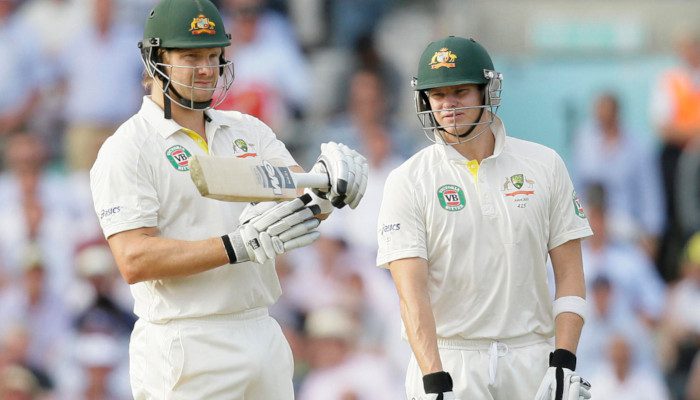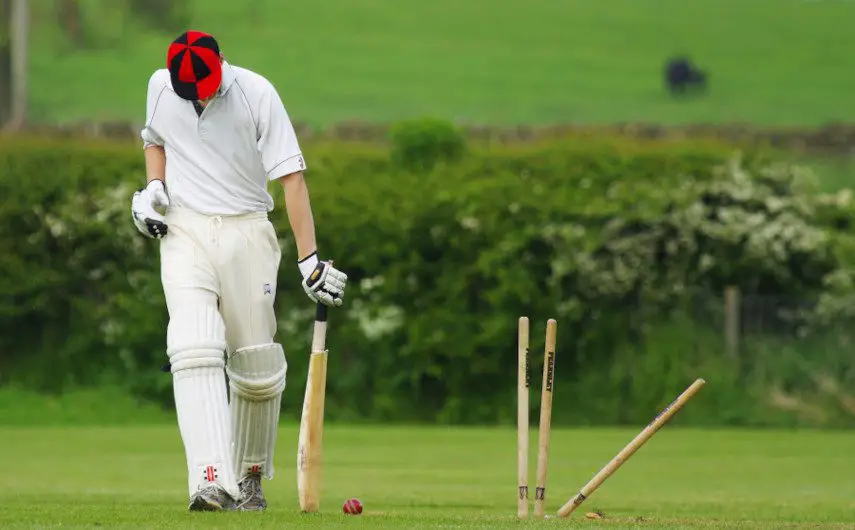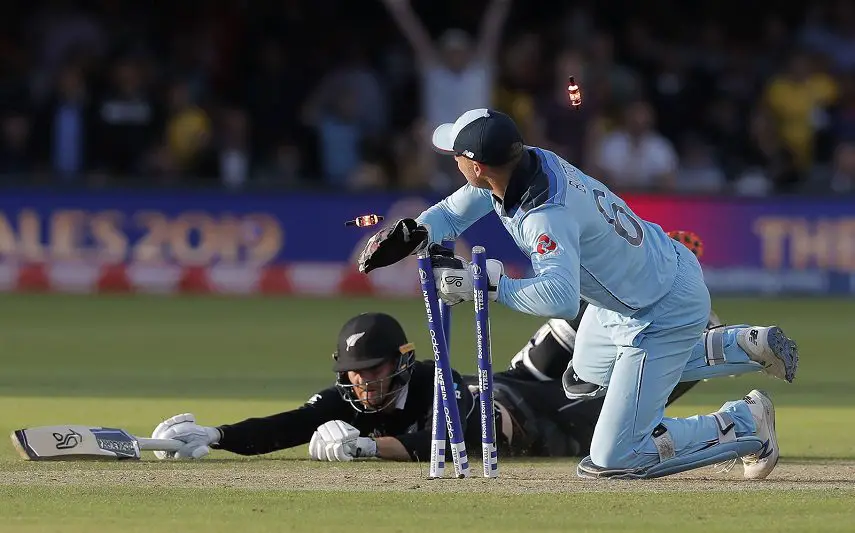Table of Contents
If a team is unhappy with a decision made by the on field umpires, they have the option for the third umpire to take a look at the standing umpire’s call. This is often referred to as DRS in cricket: By using available technology, that TV umpire can establish whether that original decision should be upheld or overturned.
DRS or UDRS is an acronym which stands for (Umpire) Decision Review System. It is a slow motion TV technology-based referral process which can be used by either side in a cricket match to assist either the umpires or referees in their decisions.
What is DRS? – In Short
DRS stands for Decision Review System which was introduced into test cricket in 2011. It was implemented to help umpires make tight calls over dismissals such as LBW, Run Out and Stumped.
Both teams are allocated a certain number of referrals for each innings (in Test cricket, two reviews per innings) and, if they feel that an incorrect decision was made by the umpires on the field, they have the right to ask for the Decision Review System to intervene. Only the fielding captain or the batter being given out have the right to have the decision reviewed. The standing umpires will then refer the decision to the third umpire in order to confirm or overturn the original call.
Using slow motion TV replays and other technology, the Television umpire will then have the final decision. It’s a significant development in the game which is in place to make sure that no major errors are made on the field.
DRS Rules and Background
How Does the Umpire Decision Review System Work?
During play, umpires are called upon to make decisions regarding dismissals. There are currently 10 ways in which a player can be given out and, in most cases, the dismissal will be obvious. If a batsman is bowled or caught on the boundary and the delivery is a legal one, the fielding team will not appeal and the batter should simply walk off the field.
In other cases, most notably Leg Before Wicket (LBW), the decision is not an obvious one and the fielding side will appeal to the on field umpire. In turn, the umpire will assess what has happened on the field and he or she will decide whether the batsman is out or not out.

If either the fielding team or the batsman do not agree with the on field umpire’s call, they have the right to refer to DRS. Referrals are also typically made by players for caught behind decisions.
Umpires also have the option to refer to DRS in cases of line decisions where the fielding team captain has appealed for a run out or stumping. Referrals would also be made to the third umpire in certain other instances – for example, if the on field umpire needs confirmation on a fair catch.
The DRS system looks at all the potential factors that are involved in the decision making process. In cases where players are asking for a referral for caught behind, it’s a fairly straightforward process for the third Umpire. Usually, the only question to consider is whether or not the batsman has hit the ball with their bat or gloves.
Ultra edge is the equipment used to uphold or overturn these decisions. Sound waves show up to interfere with a flat line and it should be clear to the umpire if those deviations are caused by the bat or ball onto the glove.
For leg before wicket decisions, the third umpire has to consider other factors that are instrumental in terms of the LBW law. Here, TV slow motion replays will confirm where the ball pitched, whether it hit the batsman in line and whether or not it is going on to hit the stumps.
A batsman cannot be given out LBW if they have hit the ball so the third umpire also uses ultra edge to determine whether bat or glove was involved before the ball hit the batsman’s pad.
For line decisions, specifically run outs and stumpings, it’s a simple case of using ultra motion cameras to determine whether the bat or any part of the batsman’s body is behind the line when the wicket is broken.
Umpire Review and Player Review
There are two types of review made to the third Umpire under the UDRS system. Umpire Reviews and Player Reviews can both take place during the course of a test match. A player review will occur if the batsman or the fielding team are unhappy with the initial decision. The third umpire will then be asked to adjudicate.
In contrast, an umpire review can be made by the two on field umpires and this will only happen if they do not have enough evidence to come to a conclusion to make an on field decision. For example, run outs and stumpings happen very quickly in real time. In most cases it’s impossible for the on field umpire to accurately judge whether the batsman had made their ground at the exact point that the wicket has been broken. Umpire reviews therefore allow the third official to use the drs technology based system in order to make the correct decision.
Similarly, the two on field umpires won’t always be able to tell whether a catch has been taken fairly. A fielder may claim a catch low down to the grass but has the ball come in contact with the ground before that fielder had control? If that question is impossible to answer on the field, an umpire review to the third umpire can clear the matter up.
Umpire’s Call
UDRS also has a feature known as Umpire’s Call which relates to marginal decisions. In cricket, the on field umpire’s decision has always been final and the Umpire’s Call rule also helps to maintain that ethos.
Introduced by the International Cricket Council in 2016, Umpire’s Call refers to marginal LBW decisions and, specifically, where the ball hits. It can either relate to where the ball pitches, where it strikes the batsman and where it strikes the wickets. If those points are marginal and less than 50% of the ball is where it needs to be, then the umpire’s call is in play and the decision will remain with the on field umpire.
Walking through the LBW process, the first point to consider is where the ball has pitched. If it pitches outside leg stump then the batsman cannot be given out leg before wicket. Following a player referral for LBW, ball tracking technology (also called Hawk Eye) will look at this question in the first instance. At least 50% of the ball needs to pitch in line for any decision to be overturned by the third umpire. If less than 50% pitches in line with leg stump, the LBW decision stays with the on field umpire.

The next part of the LBW process relates to where the ball hits the batsman. The relevant law states that a batman cannot be given out LBW if they are struck outside off stump – as long as they are playing a shot. The next steps are similar to those relating to the pitch of the ball. If at least 50% of the ball hits the batsman in line, the LBW decision can be overturned by the third umpire’s analysis. If not, that LBW decision will remain with the on field umpire.
The final point to consider is whether or not the ball would go on to hit the stumps. If at least 50% of the ball makes contact with the stumps, there is potential for the third umpire to overrule the on field umpire’s first decision. If less than 50% strikes the stumps, Umpire’s Call is in play.
UDRS Technology
When a referral is made on the field, either by a player or an umpire, the third umpire has a range of technology at their disposal. First of all, they will need television replays: The first job of a slow motion TV replay is to check that the delivery in question is legal and that the bowler hasn’t bowled a no ball.
Once that has been established, a TV replay can check whether the ball has hit the batsman’s bat or glove. On occasions, it can be obvious whether or not the bat was involved but in most cases, the third umpire will need a little extra help. This is where the next part of their equipment comes into play. Ultra Edge detects soundwaves and, when used in conjunction with those slow motion TV replays, the umpire can detect whether or not the ball has hit the bat or the glove.
Microphones can also play a part in caught behind decisions. These would be used in conjunction with a real time replay and may bring up an obvious sound of the ball hitting the bat on its way to the wicket keeper.
In some cases, all three items of technology will be used by the umpire. All dismissals will rely on TV replays to an extent while ultra edge is the second most common option.
Criticism
One possible issue with UDRS technology is the fact that it claims to only be 90% accurate. That leaves a 10% margin of error and there have been occasions when a collective naked eye feels that clear mistakes have been made.
One of the most controversial discussions around DRS involves the question of a fair catch. TV replays haven’t yet been able to adequately establish whether or not the ball has hit the ground before it comes to rest in the fielder’s hands. There is an unavoidable ‘foreshortening’ of the lens and, even with close up, zoomed images, it isn’t completely clear.
The controversy here mainly relates to the on field umpires and the fact that they are required to make a soft signal. Based on what they have seen on the field, the on field umpire is required to suggest to the TV official whether or not they think it was a legal catch. The third umpire then has to find sufficient evidence to overturn that initial on field decision.
Players feel that on field umpires should simply say that they don’t know and that the TV official has to make the final decision. That isn’t really a problem with UDRS but it is a question to be addressed in relation to the DRS rules surrounding TV replays.
DRS FAQ
How Many DRS is Allowed in Cricket?
In ODI and T20I cricket each team is allowed one DRS review per innings, while in Test cricket each team has two DRS reviews per innings. Reviews unused in the previous innings cannot be carried over to the next innings.
How Many DRS is Allowed in IPL?
In Indian Premier League cricket matches each team is allowed one DRS review per innings.
Who was the First Cricketer to be Given Out by a Third Umpire?
The first cricketer to be given out by a third umpire was Sachin Tendulkar on November 14th, 1992. Playing for India against South Africa in a test match at Kingsmead, Durban, Tendulkar was adjudged to have been run out by the third umpire Karl Liebenberg.
Third umpires have been called on to judge line decisions long before the advent of the Decision Review System. Run outs and stumpings have been assessed since 1992 and Tendulkar was the first player to fall victim to a third umpire review.
It was a tight run out call as Tendulkar attempted to make his ground but that brilliant South African fielder Jonty Rhodes was just too quick, getting the ball back to the stumps where short leg Andrew Hudson had moved to take off the bails.
In terms of the first player to be given out by the Decision Review System, it’s over to India again where Virender Sehwag claims the honour. Playing in 2008 in a test match against Sri Lanka in Colombo, an original LBW appeal was turned down by the on field umpire Mark Benson.
Muttiah Muralitharan was the bowler and the Sri Lankan team asked for the decision to be referred. DRS confirmed that the LBW appeal should have been upheld, so Sehwag was given out.
Conclusion
The introduction of technology has been seen in other sports for a number of years. Tennis, rugby and football are obvious examples and it was only natural that cricket followed. The advantages of using DRS are clear: It is there to deal with major mistakes made by the on field umpires and any obvious errors can be overturned and provided with the correct outcome.
At the same time, the authority of the standing umpires remain. Thanks to umpire’s call, the officials directly involved still get to have their say over controversial decisions. The fact that UDRS has a 90% accuracy rate is one potential downside and this is an area which can be improved in the years to come. For now, the majority of spectators, players and officials see the Decision Review System as a welcome addition to cricket.


